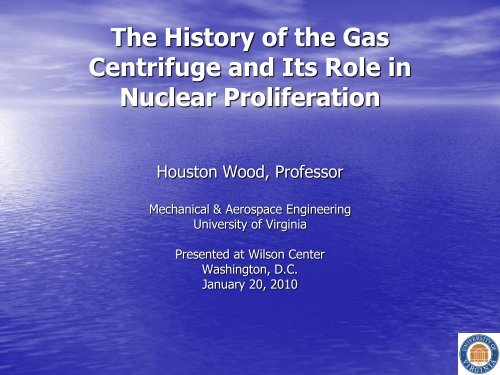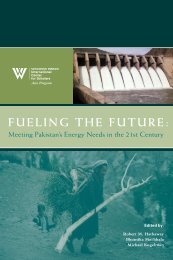Current & Future Uranium Enrichment Technologies
Current & Future Uranium Enrichment Technologies
Current & Future Uranium Enrichment Technologies
You also want an ePaper? Increase the reach of your titles
YUMPU automatically turns print PDFs into web optimized ePapers that Google loves.
The History of the Gas<br />
Centrifuge and Its Role in<br />
Nuclear Proliferation<br />
Houston Wood, Professor<br />
Mechanical & Aerospace Engineering<br />
University of Virginia<br />
Presented at Wilson Center<br />
Washington, D.C.<br />
January 20, 2010
Early Days<br />
• Isotopes were discovered in early 1900’s.<br />
• Centrifuge separation of isotopes first<br />
suggested by Lindemann and Aston (1919)<br />
• Chapman, Mulliken, Harkens and others tried<br />
unsuccessful experiments.<br />
• First successful experiments at UVA in 1934 by<br />
Prof. Jesse Beams with isotopes of Chlorine.<br />
• Attempts to use centrifuges in Manhattan<br />
project were unsuccessful.<br />
20 January 2010 Houston Wood
Professor Jesse W. Beams<br />
University of Virginia 1898 - 1977<br />
20 January 2010 Houston Wood
Early Days at UVA<br />
• Work on centrifuges during Manhattan<br />
project had a number of failures.<br />
• Project was terminated.<br />
• Concern over potential competition from<br />
German centrifuges led AEC to restart<br />
work at UVA in 1955 under guidance of<br />
A.R. Kulthau.<br />
20 January 2010 Houston Wood
Meanwhile in Europe<br />
• German research was being led by Konrad<br />
Beyerle in Göttingen and Wilhelm Groth at<br />
University of Bonn<br />
• Research in the Netherlands was being<br />
directed by Jacob Kistemaker.<br />
20 January 2010 Houston Wood
USSR<br />
• At the end of WWII, Soviets took many<br />
POWs from Germany.<br />
• They started effort to develop nuclear<br />
weapons.<br />
• Organization at Sinop:<br />
– Von Ardenne – Electromagnetic Separation<br />
– Thiessen – Gaseous Diffusion<br />
– Steenbeck Group – Included Centrifuge<br />
20 January 2010 Houston Wood
USSR (cont’d)<br />
• Competition between gaseous diffusion<br />
and gas centrifuge.<br />
• Reputed problems with GD enriching to<br />
weapons grade level.<br />
• Centrifuge considered for “topping off.”<br />
• Competition for long rotor vs. short rotor.<br />
• Steenbeck group transferred from Sinop to<br />
Kirov plant in Leningrad (~1951).<br />
20 January 2010 Houston Wood
USSR (cont’d 2)<br />
• Steenbeck managed to get concessions<br />
from the Soviets for the Germans to be<br />
released when they were successful.<br />
• Steenbeck’s group won centrifuge<br />
competition and was transferred to<br />
Leningrad in September 1953 to begin<br />
quarantine period.<br />
20 January 2010 Houston Wood
Dr. Gernot Zippe<br />
• He was a flight instructor for Germany<br />
during WW II.<br />
• Became POW in Russia after the War.<br />
• He was member of the Steenbeck group<br />
who worked on gas centrifuges.<br />
• He refused to work on the long rotors,<br />
which ultimately failed.<br />
20 January 2010 Houston Wood
Dr. Gernot Zippe: 1917 - 2008<br />
20 January 2010 Houston Wood
Zippe to USA<br />
• Dr. Oswald Francis “Mike” Schuette was US<br />
Naval Intelligence officer.<br />
• He interviewed Russian POWs, including Zippe.<br />
• US AEC was interested in Zippe.<br />
• Under a fake passport, Zippe was brought to<br />
Washington, D.C. and interviewed by Kulthau<br />
and other intelligence agents.<br />
• Zippe was then escorted to UVA by Schuette for<br />
discussions with Kulthau and others.<br />
20 January 2010 Houston Wood
Zippe to UVA<br />
• Zippe returned to UVA in 1958 under contract to<br />
AEC to reproduce work he had done in Russia.<br />
• Project’s manager was Kulthau.<br />
• Zippe was in a separate building from the<br />
Ordinance Research Lab, where classified work<br />
was underway.<br />
• Separation tests with UF 6 began in Sept. 1959<br />
and continued until end of project in May 1960.<br />
20 January 2010 Houston Wood
After 1960<br />
• Zippe went to Germany and worked for<br />
DEGUSSA, a predecessor company of<br />
what eventually became URENCO – a<br />
consortium of Britain, Germany and<br />
Netherlands.<br />
20 January 2010 Houston Wood
Dr. A. Q. Khan<br />
• Native Pakistani who worked for Urenco in<br />
the Netherlands.<br />
• Took drawings to Pakistan circa 1974<br />
• Developed gas centrifuge program in<br />
Pakistan and headed A. Q. Khan Research<br />
Institute.<br />
20 January 2010 Houston Wood
Abdul Qadeer Khan<br />
20 January 2010 Houston Wood
Spread of Centrifuges<br />
• After first Gulf War in 1991, IAEA inspectors<br />
discovered centrifuges in Iraq.<br />
• In 2002, Aluminum tubes headed for Iraq were<br />
alleged to be for centrifuges.<br />
• This was proven to be false, but the long secret<br />
subject was now being discussed in the media.<br />
• In October 2002, DPRK stated they were<br />
building a centrifuge plant.<br />
• It was known A. Q. Khan visited DPRK.<br />
• By January 2003, DPRK denied this.<br />
20 January 2010 Houston Wood
Spread – II<br />
• In Feb. 2003, IAEA inspector ElBaradei<br />
visited enrichment plant at Natanz.<br />
• During 2 nd Gulf War in 2003, Mahdi Obeidi<br />
turned over centrifuge parts buried in his<br />
back yard.<br />
• In 2004, Libya gave up their centrifuges.<br />
• Khan network of centrifuge and weapon<br />
design was involved in all of these.<br />
20 January 2010 Houston Wood
Genealogy of the Gas Centrifuge<br />
(slide provided by Alexander Glaser, PS&GS, Princeton)<br />
The Netherlands<br />
U.K.<br />
Germany<br />
Urenco<br />
Russia<br />
USA<br />
France<br />
Iran<br />
(Iraq)<br />
China<br />
N. Korea<br />
(Libya)<br />
Pakistan<br />
Japan<br />
India<br />
Brazil<br />
Australia<br />
Orig. R&D (pre-commercial, “Zippe-connection”)<br />
Tech. transfer (confirmed or planned)<br />
Indep. Dev. or unconfirmed foreign assistance<br />
Status or achievement unclear<br />
20 January 2010 Houston Wood
Gas Centrifuges & Cascades<br />
90<br />
90<br />
80<br />
80<br />
70<br />
70<br />
60<br />
60<br />
50<br />
40<br />
30<br />
20<br />
East<br />
West<br />
North<br />
50<br />
40<br />
30<br />
20<br />
East<br />
West<br />
North<br />
10<br />
10<br />
0<br />
1st<br />
Qtr<br />
2nd<br />
Qtr<br />
3rd<br />
Qtr<br />
4th<br />
Qtr<br />
0<br />
1st<br />
Qtr<br />
2nd<br />
Qtr<br />
3rd<br />
Qtr<br />
4th<br />
Qtr<br />
20 January 2010 Houston Wood
Separative Work<br />
• <strong>Enrichment</strong> of uranium is measured by<br />
separative work units (SWU) in kgU.<br />
• Separative capacity is SWU per unit time.<br />
• To fuel a typical power reactor requires<br />
separative capacity ~125,000 SWU/yr.<br />
• If a single centrifuge has ΔU = 10<br />
SWU/yr, the cascade requires 12,500<br />
centrifuges.<br />
20 January 2010 Houston Wood
20 January 2010 Houston Wood
Source: Zippe G., Development and status of gas centrifuge<br />
technology, Proc. 7th Workshop on Separation Phenomena in Liquids<br />
and Gases, July 24-28, 2000, Moscow, Russia, pp.35-53.<br />
20 January 2010 Houston Wood
Centrifuge Hall / Almelo<br />
20 January 2010 Houston Wood
U.S. Centrifuges<br />
20 January 2010 Houston Wood
Dual Use<br />
• Any uranium enrichment process can be<br />
used to make material for fuel in a nuclear<br />
power reactor or for a bomb.<br />
• The line between civilian and military use<br />
is very thin.<br />
• Are there ways to thicken this line<br />
20 January 2010 Houston Wood
Thickening the Line<br />
• Transparency and inspections.<br />
• Safeguards.<br />
• Materials accountability and control.<br />
• Defining a trigger event.<br />
• Clearly stating the response to the trigger.<br />
• Clandestine facilities are another issue.<br />
20 January 2010 Houston Wood
Questions<br />
Comments<br />
20 January 2010 Houston Wood

















